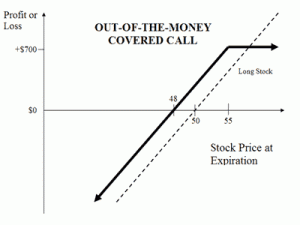A strategy in options trading whereby call options are written against a holding of the underlying security, is a covered call. The investor using a covered call gets to earn a premium writing calls while at the same time appreciate all benefits of underlying stock ownership, such as dividends and voting rights, unless he is assigned an exercise notice on the written call and is obligated to sell his shares.
However, the profit potential of covered call writing is limited as the investor had, in return for the premium, given up the chance to fully profit from a substantial rise in the price of the underlying asset.
Limited Profit Potential
In addition to the premium received for writing the call, the OTM covered call strategy’s profit also includes a paper gain if the underlying stock price rises, up to the strike price of the call option sold.
The formula for calculating maximum profit is given below:
- Max Profit = Premium Received – Purchase Price of Underlying + Strike Price of Short Call – Commissions Paid
- Max Profit Achieved When Price of Underlying >= Strike Price of Short Call
Unlimited Loss Potential
Potential losses for this strategy can be very large and occurs when the price of the underlying security falls. However, this risk is no different from that which the typical stockowner is exposed to. In fact, the covered call writer’s loss is cushioned slightly by the premiums received for writing the calls.
The formula for calculating loss is given below:
